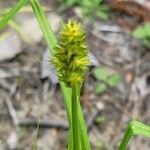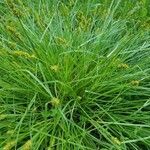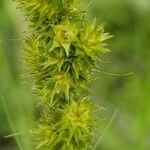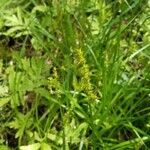Rhizome short. Culms tufted, 40-70 cm tall, compressed trigonous, scabrous above, leafy in middle or lower, clothed at base with black-brown bladeless sheaths disintegrating into fibers. Leaves shorter or longer than culm, blades pale green, 6-7 mm wide, flat, soft, margins serrulate, apex acuminate; membranous side of leaf sheath usually transversely wrinkled. Lower involucral bracts setaceous, upper ones glumelike. Inflorescence cylindric, sometimes slightly branching, 3.5-5 × 1-1.5 cm; spikes androgynous, slightly stellate patent, simple above, branched below. Female glumes pale green, ovate, 3-4 × ca. 1.8 mm, green 1-veined costa excurrent into an awn 0.5-1.2 mm. Utricles pale ferruginous, longer than glume, cuneate-lanceolate, plano-convex, 4-5 mm, membranous, lustrous, many veined abaxially, base spongy, shortly stipitate, upper margins narrowly serrate winged, apex gradually narrowed into a serrate-margined long beak, beak cleft abaxially, 2-toothed at orifice. Nutlets tightly enveloped, broadly ovate, plano-convex or slightly biconvex, 1.5-1.7 mm, base shortly stipitate; style base slightly thickened; stigmas 2. Fl. and fr. Jul. 2n = 48, 52.
More
Plants with basal sheaths of previous year not persistent. Culms easily compressed, to 120 cm × 7 mm, scabrous. Leaves: sheaths usually all with blades, green; fronts rugose, indistinctly linearly veined, apex colorless, fragile, convex, not forming extension, erose; ligules acute, 10 mm, free limb to 0.8 mm; blades not epistomic, to 100 cm × 15 mm. Inflorescences densely spicate, elongate, cylindric, with 15–25 distinguishable branches, 5–15 × 4 cm; proximal internode to 10 mm. Scales hyaline. Perigynia pale brown with red-brown veins, 15-veined abaxially, 7-veined adaxially, to 6 × 2 mm, base distended proximally, cordate; stipe to 0.4 mm; beak to 3.5 mm, serrulate. Achenes ovate, to 2 × 1.5 mm; stalk to 0.3 mm; persistent style base cylindric.





